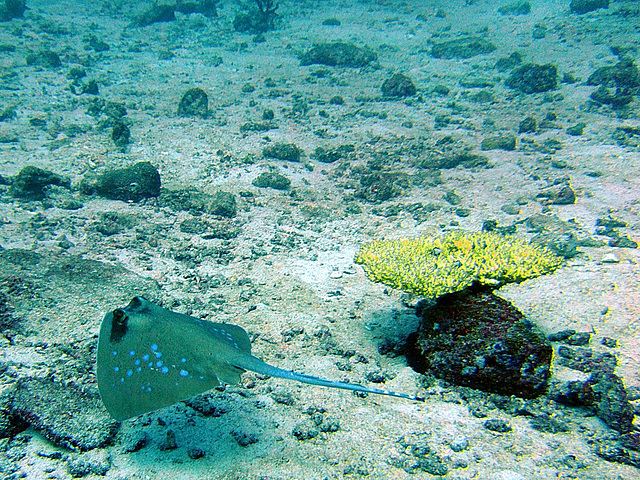A boxfish or cofferfish
School of snapper fishes
Caesionidae, yellowback fusilier fishes
We reach the coral reef
Five minutes at five meters security stop
Diving in the group
Dive down fast, go up slow
Bleached sea fans
This trigger fish attacked me short time later
Trigger wanted
Slate sweet lip fish
First encounter
School of snappers
Under water landscape
Barracuda in its position behind the fish swarm
Night dive
School of butterflyfishes
Fusilier fish with remarkable colors
Uncountable fish
Fishing boats anchor for overnight
Corals grow up
Drifting along the reef
Colorful soft corals
Moray eel in free water out of the cave
Diving partner behind a fish swarm
Waiting for the sharks
Lobster looks out its cave
Brilliant blue doctor fish
Sea fans in different colors
Cuttlefish and its camouflage
School of fusiliers
Streaked Spinefoot
Fish swarm over soft corals
Streaked Spinefoot fish in foreground
Pterois known as Lionfish
Our Saimai fixed on a mooring
Moray looks out the cave
The view from the ground
Titan trigger fish and its nest
Under water sea fan
A leopard shark at the morning dive
Dive partner
Watch the corals
Kwan Phayao Lake, Thailand
Prasat Pre Rup in sunset light
See also...
Keywords
Authorizations, license
-
Visible by: Everyone -
All rights reserved
-
628 visits
Blue pointed sting ray


Stingrays are usually very docile and curious, their usual reaction being to flee any disturbance, but they will sometimes brush their fins past any new object they encounter. Nevertheless, certain larger species may be more aggressive and should be approached with caution, as the stingray's defensive reflex (use of its poisoned stinger) may result in serious injury or death.
We do encounter the sting ray with respect and alway looking down to the ground when we touch the sand.
The International Union for Conservation of Nature (IUCN) has assessed the bluespotted ribbontail ray as Near Threatened. Although still relatively common and widely distributed, this species faces continuing degradation of its coral reef habitat throughout its range, from development and destructive fishing practices using cyanide or dynamite. In addition, its populations are under heavy pressure by artisanal and commercial fisheries, and by local collecting for the aquarium trade.
We do encounter the sting ray with respect and alway looking down to the ground when we touch the sand.
The International Union for Conservation of Nature (IUCN) has assessed the bluespotted ribbontail ray as Near Threatened. Although still relatively common and widely distributed, this species faces continuing degradation of its coral reef habitat throughout its range, from development and destructive fishing practices using cyanide or dynamite. In addition, its populations are under heavy pressure by artisanal and commercial fisheries, and by local collecting for the aquarium trade.
- Keyboard shortcuts:
Jump to top
RSS feed- Latest comments - Subscribe to the comment feeds of this photo
- ipernity © 2007-2025
- Help & Contact
|
Club news
|
About ipernity
|
History |
ipernity Club & Prices |
Guide of good conduct
Donate | Group guidelines | Privacy policy | Terms of use | Statutes | In memoria -
Facebook
Twitter

Sign-in to write a comment.